The resources linked below are intended for broad distribution and may be freely reproduced, printed, and disseminated as long as no changes are made to them.
- Eclipse Guide for Libraries & Communities
- Guide to Planning Eclipse Events
- Book on Lessons Learned from the 2017 Eclipse
- Solar Eclipse Safety Flyers
- Technical Report on Solar Eclipse Eye Safety
- Journal Article on Solar Filters and the ISO 12312-2 Standard
- White Paper on Community Solar Eclipse Planning
- DomPrep Journal Article on Preparing Your Community
- TR News Article on Eclipse-Related Traffic
- Instructions for Building a Sun Funnel
- Derrick Pitts's Solar-Eclipse-Viewing Tent
- Great North American Solar Eclipse Poster
- Sun...Moon...You! Postcard
- Eclipse.aas.org Business Card
- Eclipse.aas.org Stickers
Also, see our Royalty-free Images & Videos page.
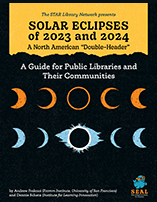 "Solar Eclipses of 2023 and 2024: A North American 'Double-Header'" is subtitled "A Guide for Public Libraries and Their Communities," but it contains so much useful information that anyone preparing their community for the coming eclipses should grab a copy — it's free! Authors of the 36-page PDF are renowned astronomy educators Andrew Fraknoi and Dennis Schatz, who are also members of the AAS Solar Eclipse Task Force. Topics include how and why solar eclipses happen, how to watch them safely, where to get safe eclipse glasses and how to use them properly, and ideas for eclipse events and educational activities. Note that the PDF is a 34-megabyte download.
"Solar Eclipses of 2023 and 2024: A North American 'Double-Header'" is subtitled "A Guide for Public Libraries and Their Communities," but it contains so much useful information that anyone preparing their community for the coming eclipses should grab a copy — it's free! Authors of the 36-page PDF are renowned astronomy educators Andrew Fraknoi and Dennis Schatz, who are also members of the AAS Solar Eclipse Task Force. Topics include how and why solar eclipses happen, how to watch them safely, where to get safe eclipse glasses and how to use them properly, and ideas for eclipse events and educational activities. Note that the PDF is a 34-megabyte download.
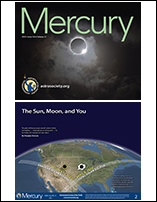 "The Sun, Moon, and You" will help you prepare yourself, students, friends, and neighbors — and provide tips on running events — for the October 2023 and April 2024 solar eclipses. Written by astronomer and eclipse chaser Douglas Duncan and published in Mercury by the Astronomical Society of the Pacific, this 11-page PDF covers the differences between partial, annular, and total solar eclipses; how to view solar eclipses safely; how to shoot (and why not to shoot) photos; and how to plan an eclipse-watching event in your community.
"The Sun, Moon, and You" will help you prepare yourself, students, friends, and neighbors — and provide tips on running events — for the October 2023 and April 2024 solar eclipses. Written by astronomer and eclipse chaser Douglas Duncan and published in Mercury by the Astronomical Society of the Pacific, this 11-page PDF covers the differences between partial, annular, and total solar eclipses; how to view solar eclipses safely; how to shoot (and why not to shoot) photos; and how to plan an eclipse-watching event in your community.
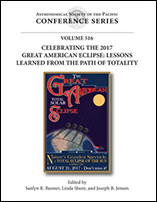 "Celebrating the 2017 Great American Eclipse: Lessons Learned from the Path of Totality" is Vol. 516 of the Astronomical Society of the Pacific Conference Series. Having sold out of the printed book, the ASP has kindly made its 60 contributed articles freely available as PDFs. Whatever your role in preparing for the coming American solar eclipses, you'll find many valuable tips on these pages. Our links point to a list of the articles on the NASA/SAO Astrophysics Data System (ADS). Click on any article title to go to its corresponding abstract page; from there you can download the PDF.
"Celebrating the 2017 Great American Eclipse: Lessons Learned from the Path of Totality" is Vol. 516 of the Astronomical Society of the Pacific Conference Series. Having sold out of the printed book, the ASP has kindly made its 60 contributed articles freely available as PDFs. Whatever your role in preparing for the coming American solar eclipses, you'll find many valuable tips on these pages. Our links point to a list of the articles on the NASA/SAO Astrophysics Data System (ADS). Click on any article title to go to its corresponding abstract page; from there you can download the PDF.
 "How to Safely View the April 8, 2024, Total Solar Eclipse" is a 1-page flyer intended for the general public. If you're selling or giving away "eclipse glasses" or handheld solar viewers at an eclipse-watching event, we recommend that you hand out this flyer along with the manufacturer's instructions. The flyer was developed jointly by the AAS, NASA, NSF, and NOAA and has been endorsed by numerous medical associations (see our eye-safety page). NASA and the AAS collaborated to get the flyer translated into eight languages; some of the flyers linked below have two pages, with Engiish on the first page and the other language on the second page.
"How to Safely View the April 8, 2024, Total Solar Eclipse" is a 1-page flyer intended for the general public. If you're selling or giving away "eclipse glasses" or handheld solar viewers at an eclipse-watching event, we recommend that you hand out this flyer along with the manufacturer's instructions. The flyer was developed jointly by the AAS, NASA, NSF, and NOAA and has been endorsed by numerous medical associations (see our eye-safety page). NASA and the AAS collaborated to get the flyer translated into eight languages; some of the flyers linked below have two pages, with Engiish on the first page and the other language on the second page.
- Solar Eclipse Safety Flyer, English
- Solar Eclipse Safety Flyer, French
- Solar Eclipse Safety Flyer, Spanish
- Solar Eclipse Safety Flyer, Arabic
- Solar Eclipse Safety Flyer, Chinese Simplified
- Solar Eclipse Safety Flyer, Chinese Traditional
- Solar Eclipse Safety Flyer, Korean
- Solar Eclipse Safety Flyer, Tagalog
- Solar Eclipse Safety Flyer, Vietnamese
 "Solar Eclipse Eye Safety" is a 9-page technical report written for the American Astronomical Society by Ralph Chou, Professor Emeritus in the School of Optometry & Vision Science at the University of Waterloo, Ontario, Canada. Dr. Chou was lead writer for the ISO 12312-2 standard on filters for direct observation of the Sun, which was adopted worldwide in 2015, and is widely recognized as a leading expert on protective solar filters. His report is intended for astronomers, educators, health-care professionals, the media, and anyone else who wants to understand how sunlight can damage the eye and what constitutes a safe solar filter.
"Solar Eclipse Eye Safety" is a 9-page technical report written for the American Astronomical Society by Ralph Chou, Professor Emeritus in the School of Optometry & Vision Science at the University of Waterloo, Ontario, Canada. Dr. Chou was lead writer for the ISO 12312-2 standard on filters for direct observation of the Sun, which was adopted worldwide in 2015, and is widely recognized as a leading expert on protective solar filters. His report is intended for astronomers, educators, health-care professionals, the media, and anyone else who wants to understand how sunlight can damage the eye and what constitutes a safe solar filter.
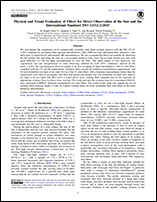 "Physical and Visual Evaluation of Filters for Direct Observation of the Sun and the International Standard ISO 12312-2:2015" is an 8-page open-access article in the September 2021 issue of the Astronomical Journal. Authors Ralph Chou, Stephen Dain, and Rick Fienberg — all members of the technical committee responsible for the ISO 12312-2 standard — evaluate samples of "eclipse glasses" and other solar viewers from 2017 against the standard and are developing some modifications to the standard based on their results. Our links point to the free article on the Astronomical Journal website, where you can download a free PDF of the article if you wish.
"Physical and Visual Evaluation of Filters for Direct Observation of the Sun and the International Standard ISO 12312-2:2015" is an 8-page open-access article in the September 2021 issue of the Astronomical Journal. Authors Ralph Chou, Stephen Dain, and Rick Fienberg — all members of the technical committee responsible for the ISO 12312-2 standard — evaluate samples of "eclipse glasses" and other solar viewers from 2017 against the standard and are developing some modifications to the standard based on their results. Our links point to the free article on the Astronomical Journal website, where you can download a free PDF of the article if you wish.
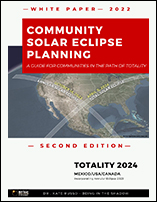 "Community Solar Eclipse Planning" is a 34-page primer on how to prepare your community for a total solar eclipse. Author Kate Russo is a psychologist and eclipse-chaser whose books Total Addiction and Being in the Shadow explore what drives some people to organize their lives around experiencing total eclipses of the Sun. Dr. Russo has helped communities large and small, in several countries, get ready for an influx of eclipse-chasers. If your city or town lies within the path of totality on April 8, 2024, and you're a government, public-safety, public-health, or tourist-industry official, this white paper is for you.
"Community Solar Eclipse Planning" is a 34-page primer on how to prepare your community for a total solar eclipse. Author Kate Russo is a psychologist and eclipse-chaser whose books Total Addiction and Being in the Shadow explore what drives some people to organize their lives around experiencing total eclipses of the Sun. Dr. Russo has helped communities large and small, in several countries, get ready for an influx of eclipse-chasers. If your city or town lies within the path of totality on April 8, 2024, and you're a government, public-safety, public-health, or tourist-industry official, this white paper is for you.
- White Paper on Community Solar Eclipse Planning (download from this AAS website)
- White Paper on Community Solar Eclipse Planning (download from Kate Russo's website)
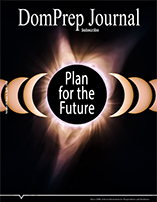 "Eclipses Again Will Darken the Sky in 2023 and 2024" is an article from the April 2023 issue of DomPrep Journal, published by the Texas Division of Emergency Management. Author Laurie Radow, formerly of the U.S. Dept. of Transportation, shares lessons learned from the experiences — both good and not so good — of communities along the path of the August 2017 solar eclipse. Preparedness professionals know how to train, prepare, and respond to a natural disaster, but that doesn't mean they know what to do when a solar eclipse is coming. Radow addresses some of the issues that mustn't be overlooked when working with community partners and developing plans.
"Eclipses Again Will Darken the Sky in 2023 and 2024" is an article from the April 2023 issue of DomPrep Journal, published by the Texas Division of Emergency Management. Author Laurie Radow, formerly of the U.S. Dept. of Transportation, shares lessons learned from the experiences — both good and not so good — of communities along the path of the August 2017 solar eclipse. Preparedness professionals know how to train, prepare, and respond to a natural disaster, but that doesn't mean they know what to do when a solar eclipse is coming. Radow addresses some of the issues that mustn't be overlooked when working with community partners and developing plans.
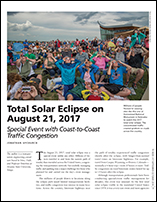 "Total Solar Eclipse on August 21, 2017: Special Event with Coast-to-Coast Traffic Congestion" is an article from the September-October 2018 issue of TR News — a transportation industry magazine — examining the unprecedented traffic congestion that occurred as people departed their observing sites after the "Great American Eclipse." Lessons learned from that event, along with an understanding that viewers will travel by the millions, can help transportation agencies, public-safety departments, and local communities be better prepared for the April 8, 2024, total solar eclipse. The single best piece of advice: Find ways to encourage visitors to arrive early and, most importantly, stay late rather than hit the road immediately after the eclipse.
"Total Solar Eclipse on August 21, 2017: Special Event with Coast-to-Coast Traffic Congestion" is an article from the September-October 2018 issue of TR News — a transportation industry magazine — examining the unprecedented traffic congestion that occurred as people departed their observing sites after the "Great American Eclipse." Lessons learned from that event, along with an understanding that viewers will travel by the millions, can help transportation agencies, public-safety departments, and local communities be better prepared for the April 8, 2024, total solar eclipse. The single best piece of advice: Find ways to encourage visitors to arrive early and, most importantly, stay late rather than hit the road immediately after the eclipse.
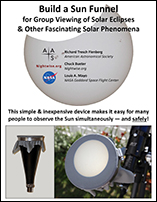 "Build a Sun Funnel for Group Viewing of Solar Eclipses & Other Fascinating Solar Phenomena" is a step-by-step illustrated guide to constructing a simple, inexpensive device that enables multiple people to observe a projected image of the Sun simultaneously and safely. Written by Rick Fienberg (AAS), Chuck Bueter (NightWise.org), and Lou Mayo (then at NASA's Goddard Space Flight Center), the document is intended for amateur and professional astronomers who know how to operate a telescope for solar observing and includes a detailed explanation of the mathematical underpinnings of the Sun Funnel design (or not, as you wish).
"Build a Sun Funnel for Group Viewing of Solar Eclipses & Other Fascinating Solar Phenomena" is a step-by-step illustrated guide to constructing a simple, inexpensive device that enables multiple people to observe a projected image of the Sun simultaneously and safely. Written by Rick Fienberg (AAS), Chuck Bueter (NightWise.org), and Lou Mayo (then at NASA's Goddard Space Flight Center), the document is intended for amateur and professional astronomers who know how to operate a telescope for solar observing and includes a detailed explanation of the mathematical underpinnings of the Sun Funnel design (or not, as you wish).
- Instructions for Building a Sun Funnel
- Instructions for Building a Sun Funnel (without all the math)
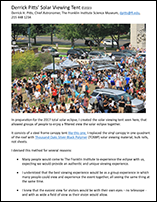 "Derrick Pitts's Solar-Eclipse-Viewing Tent" describes the clever device created by the Franklin Institute's chief astronomer to enable groups of people to watch a solar eclipse together while standing in the shade. In this 4-page illustrated PDF, Pitts explains the rationale behind his invention, lists the materials and fasteners you'll need to build one yourself, and tells where to get the parts you won't find at your local hardware store. If you're hosting a large crowd for a solar eclipse, you should seriously consider building one (or more!) of these viewing canopies.
"Derrick Pitts's Solar-Eclipse-Viewing Tent" describes the clever device created by the Franklin Institute's chief astronomer to enable groups of people to watch a solar eclipse together while standing in the shade. In this 4-page illustrated PDF, Pitts explains the rationale behind his invention, lists the materials and fasteners you'll need to build one yourself, and tells where to get the parts you won't find at your local hardware store. If you're hosting a large crowd for a solar eclipse, you should seriously consider building one (or more!) of these viewing canopies.
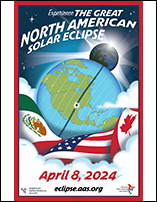 "Experience the Great North American Solar Eclipse" is an 11-by-17-inch full-color poster created for the AAS Solar Eclipse Task Force by astronomer-artist Tyler Nordgren (Space Art Travel Bureau). We are making it available to download for free and use online and/or to print and frame or otherwise display at your own expense. Click on the thumbnail at left to see all three versions: English, Spanish, and French. The files linked below are 4-megabyte JPGs sized for 300 dpi printing at 100%, i.e., 11 x 17 inches.
"Experience the Great North American Solar Eclipse" is an 11-by-17-inch full-color poster created for the AAS Solar Eclipse Task Force by astronomer-artist Tyler Nordgren (Space Art Travel Bureau). We are making it available to download for free and use online and/or to print and frame or otherwise display at your own expense. Click on the thumbnail at left to see all three versions: English, Spanish, and French. The files linked below are 4-megabyte JPGs sized for 300 dpi printing at 100%, i.e., 11 x 17 inches.
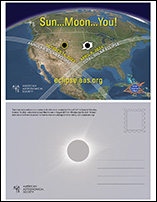 "Sun...Moon...You! Postcard" is the artwork for the two-sided postcard that members of the AAS Solar Eclipse Task Force give out at every opportunity to promote the 2023 and 2024 North American solar eclipses and the resources on this website. Click on the thumbnail at left to see both sides in one JPEG image. The files linked below are 15- and 3-megabyte PDFs suitable for use in printing a 4-by-6-inch postcard at 300 dpi. The postcard is designed to meet U.S. Postal Service requirements. Print some and mail them to your friends and relatives so they'll be sure not to miss the upcoming eclipses!
"Sun...Moon...You! Postcard" is the artwork for the two-sided postcard that members of the AAS Solar Eclipse Task Force give out at every opportunity to promote the 2023 and 2024 North American solar eclipses and the resources on this website. Click on the thumbnail at left to see both sides in one JPEG image. The files linked below are 15- and 3-megabyte PDFs suitable for use in printing a 4-by-6-inch postcard at 300 dpi. The postcard is designed to meet U.S. Postal Service requirements. Print some and mail them to your friends and relatives so they'll be sure not to miss the upcoming eclipses!
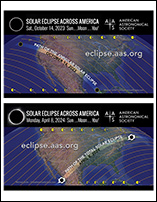 "Eclipse.aas.org Business Card" is the artwork for the two-sided business card that members of the AAS Solar Eclipse Task Force give out at every opportunity to promote the 2023 and 2024 North American solar eclipses and the resources on this website. Click on the thumbnail at left to see both sides in one JPEG image. The files linked below are 3½-megabyte PDFs suitable for use in printing a standard U.S. business card at 300 dpi (with some bleed provided to account for uncertainty in trimming).
"Eclipse.aas.org Business Card" is the artwork for the two-sided business card that members of the AAS Solar Eclipse Task Force give out at every opportunity to promote the 2023 and 2024 North American solar eclipses and the resources on this website. Click on the thumbnail at left to see both sides in one JPEG image. The files linked below are 3½-megabyte PDFs suitable for use in printing a standard U.S. business card at 300 dpi (with some bleed provided to account for uncertainty in trimming).
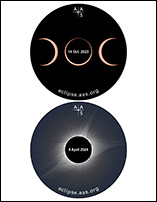 "Eclipse.aas.org Stickers" is the artwork for two 3-inch round stickers that members of the AAS Solar Eclipse Task Force give out at every opportunity to promote the 2023 and 2024 North American solar eclipses and the resources on this website. Click on the thumbnail at left to see both stickers in one JPEG image. The files linked below are 4½-megabyte TIFFs suitable for use in printing standard 3-inch round stickers at 300 dpi (with a thin white border around each sticker).
"Eclipse.aas.org Stickers" is the artwork for two 3-inch round stickers that members of the AAS Solar Eclipse Task Force give out at every opportunity to promote the 2023 and 2024 North American solar eclipses and the resources on this website. Click on the thumbnail at left to see both stickers in one JPEG image. The files linked below are 4½-megabyte TIFFs suitable for use in printing standard 3-inch round stickers at 300 dpi (with a thin white border around each sticker).
- Sticker Promoting the Annular Solar Eclipse of October 14, 2023
- Sticker Promoting the Total Solar Eclipse of April 8, 2024

